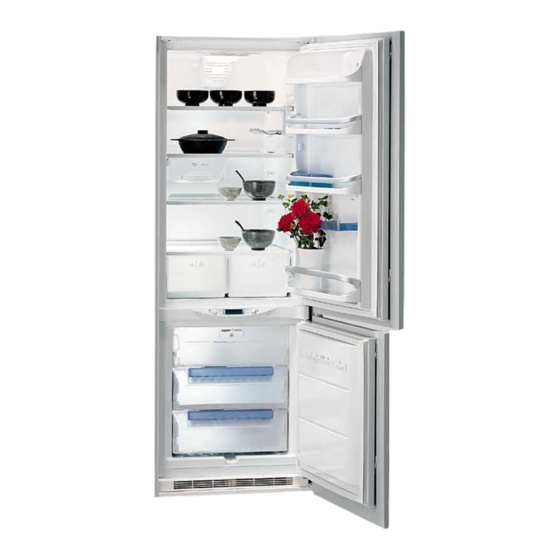Ariston RG 2330 Panduan Petunjuk Pengoperasian - Halaman 11
Jelajahi secara online atau unduh pdf Panduan Petunjuk Pengoperasian untuk Kulkas Ariston RG 2330. Ariston RG 2330 20 halaman. 2-door fridge
Juga untuk Ariston RG 2330: Panduan Petunjuk Pengoperasian (48 halaman), Panduan Petunjuk Pengoperasian (20 halaman)

responsible for their safety. Children should be supervised to
ensure that they do not play with the appliance.
• Keep packaging material out of the reach of children! It can
become a choking or suffocation hazard.
Disposal
• Observe local environmental standards when disposing
packaging material for recycling purposes.
• The European Directive 2002/96/EC on Waste Electrical and
Electronic Equipment (WEEE), requires that old household
electrical appliances must not be disposed of in the normal
unsorted municipal waste stream. Old appliances must be
collected separately in order to optimise the recovery and
recycling of the materials they contain and reduce the impact
on human health and the environment. The crossed out
"wheeled bin" symbol on the product reminds you of your
obligation, that when you dispose of the appliance it must be
separately collected. Consumers should contact their local
authority or retailer for information concerning the correct
disposal of their old appliance.
Respecting and conserving the
environment
• Install the appliance in a fresh and well-ventilated room. Ensure
that it is protected from direct sunlight and do not place it near
heat sources.
• Try to avoid keeping the door open for long periods or opening
the door too frequently in order to conserve energy.
• Do not fill the appliance with too much food: cold air must
circulate freely for food to be preserved properly. If circulation
is impeded, the compressor will work continuously.
• Do not place hot food directly into the refrigerator. The internal
temperature will increase and force the compressor to work
harder and will consume more energy.
• Defrost the appliance if ice forms (see Maintenance). A thick
layer of ice makes cold transference to food products more
difficult and results in increased energy consumption.
Troubleshooting
If the appliance does not work, before calling for Assistance (see
Assistance), check for a solution from the following list.
The display is completely switched off.
• The plug has not been inserted into the electrical socket, or not
far enough to make contact, or there is no power in the house.
The motor does not start.
• The appliance comes with a motor protection control (see
Start-up and use).
The display is on but it is dim.
• Pull out and reverse the plug before putting it back in the socket.
The alarm sounds and DOOR OPEN ALARM flashes on the
display ("d" is displayed instead of the REFRIGERATOR
temperature).
• The refrigerator door has been open for more than two minutes.
The sound alert stops when the door is closed or when the
appliance is switched off and on again.
The alarm sounds and TEMPERATURE ALARM flashes
on the display ("A1" is displayed instead of the FREEZER
temperature).
• The temperature inside the freezer is too high. The freezer will
maintain a temperature of around 0°C so that the food will not
refreeze, allowing you to eat it within 24 hours or to refreeze it
after it has been cooked.
To switch off the buzzer, open and close the appliance door
or press the + and – freezer temperature adjustment buttons
once. Press these buttons a second time to display the set
value on the freezer display, switch off the TEMPERATURE
ALARM LED and restore normal operation.
The alarm sounds and temperature alarm flashes on
the display ("A2" is displayed instead of the FREEZER
temperature).
• The temperature of the freezer is dangerously high: the
food inside must not be eaten. The freezer will maintain a
temperature of approximately -18°C.
To switch off the buzzer, open and close the appliance door
or press the + and – freezer temperature adjustment buttons
once. Press these buttons a second time to display the set
value on the freezer display, switch off the TEMPERATURE
ALARM LED and restore normal operation.
The refrigerator and the freezer do not cool well.
• The doors do not close properly or the seals are damaged.
• The doors are opened too frequently.
• The temperature that has been set is too high (see Start-up
and use).
• The refrigerator or the freezer have been over-filled.
• The atmospheric temperature of the area surrounding the
appliance is lower than 14°C.
The food inside the refrigerator is beginning to freeze.
• The temperature that has been set is too low (see Start-up and
use).
The motor runs continuously.
• The functions are active SPEED COOL and / or SUPER FREEZE.
• The door is not closed properly or is continuously opened.
• The outside ambient temperature is very high.
The appliance makes a lot of noise.
• The appliance has been installed between cabinets that vibrate
and make noise.
• The internal refrigerant makes a slight noise even when the
compressor is off. This is not a defect, it is normal.
There is water at the bottom of the refrigerator.
• The water discharge hole is blocked (see Maintenance).
GB
11
